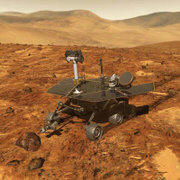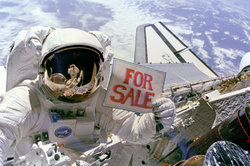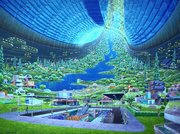|
   
> History
> Space Craft
> Unmanned Space Programs
> Animals in Space
> Human in Space
> Human in Moon
> Manned Space Programs
> Space Station
> Voyager 1
> Voyager 2
> Hubble Space Telescope
> Recent & Future Developments
       
|
Exploration of Mars
The exploration of Mars has been an important part of the
space exploration missions of the Soviet Union (later Russia), the United
States, Europe, and Japan. Dozens of unmanned spacecraft, including
orbiters, landers, and rovers, have been launched toward Mars since the
1960s. These missions were aimed at gathering data and answering questions
about the red planet and its past that may yield further insight into
Earth's past, present, and future.
 |
Rovers on Mars
Computer generated image of one of the two
Mars Exploration Rovers which touched down on Mars in 2004. |
The exploration of Mars has come at a considerable financial cost with
roughly two-thirds of all spacecraft destined for Mars failing before
completing or even beginning their missions. Part of this high failure
rate can be ascribed to the large number of things that can go wrong, but
enough have either failed or lost communications for no apparent reason
that some researchers half-jokingly speak of an Earth-Mars "Bermuda
Triangle" or of a Great Galactic Ghoul which subsists on a diet of Mars
probes. This phenomenon is also known widely as the Mars Curse.
[Top]
Mars Exploration Rovers
Shortly after the launch of Mars Express, NASA sent a pair
of twin rovers toward the planet as part of the Mars Exploration Rover
Mission. On June 10, 2003, NASA's MER-A (Spirit) Mars Exploration Rover
was launched. It successfully landed in Gusev Crater (believed once to
have been a crater lake) on January 3, 2004. It examined rock and soil for
evidence of the area's history of water. On July 7, 2003, a second rover,
MER-B (Opportunity) was launched. It landed on January 24, 2004 in
Meridiani Planum (where there are large deposits of hematite, indicating
the presence of past water) to carry out similar geological work.
Despite technical difficulties with the rovers (believed to have been
caused by corrupted flash memory) delaying exploration for several days,
both rovers eventually began exploring their landing sites. The rover
Opportunity landed in a particularly interesting spot, a crater with
bedrock outcroppings. In fast succession mission team members announced on
March 2 that data returned from the rover showed that these rocks were
once "drenched in water", and on March 23 that it was concluded that they
were laid down under-water in a salty sea. This represented the first
strong direct evidence for liquid water being on Mars at some time in the
past.
As of September 28, 2005, both rovers are still healthy, though starting
to show their ages in ways that require occasional intervention from
Earth, and discovering new things, including Heat Shield Rock, the first
meteorite to be discovered on another planet.
By the end of July 2005, it was reported by the Sunday Times that the
rovers may have carried the bacteria Bacillus safensis to Mars. According
to one NASA microbiologist, this bacteria could survive both the trip and
conditions on Mars. A book containing this claim, 'Out of Eden' by Alan
Burdick, is due to be published in the United Kingdom later in 2005,
though it must be mentioned that neither of the spacecrafts to reach
surface of Mars was completely sterile. [Top]
Future Missions
The next mission to Mars is the Phoenix Mars lander,
expected to launch in 2007.
It should be followed by a (or a couple of) more capable rovers in 2009 or
2011 and by the European ExoMars mission in 2011. A second Scout mission
should also be selected soon for 2011. The next mission could be a Mars
Sample Return, starting no earlier as 2013, more probably during the next
launch window 2016.
Russia is still planning to launch its Phobos-Grunt probe in 2009.
[Top]
Manned Missions
Many people, from Wernher von Braun on, have long
advocated a manned mission to Mars as the next logical step for a manned
space program after lunar exploration. Aside from the prestige such a
mission would bring, advocates argue that humans would be easily able to
outperform robotic explorers, justifying the expenses.
Because of the distance between Mars and Earth, the mission would be much
more risky and more expensive than past manned flights to the Moon.
Supplies and fuel would have to be prepared for a 2-3 year round trip and
the spacecraft would have to be designed with at least partial shielding
from intense solar radiation. A proposal called Mars Direct, advocated by
Robert Zubrin of the Mars Society, is believed by many to be the most
practical and affordable plan for a manned Mars mission.
United States President George W. Bush announced an initiative of manned
space exploration on January 14, 2004, known as the Vision for Space
Exploration. It includes a manned return to the moon by 2015 at the
earliest, and suggests that manned missions to Mars may become a
possibility at some point in the future. The European Space Agency has the
long-term vision of sending a human mission to Mars by 2030, the Aurora
Programme.
In the even longer term (centuries hence), some scientists believe Mars to
be a good candidate for terraforming and human colonization, though other
prominent skeptics (such as Robert L. Park) dispute the practicality of
both. Many scientists have argued that if life is found on Mars, all human
activities on the planet should be carried out with the goal of
preservation in mind. Others argue that the presence of life on Mars would
imply that life is prevalent throughout the universe; decreasing the
relative importance of Martian microbes.
Paul Davies, professor at the Australian Centre for Astrobiology, believes
that a one-way mission to Mars will greatly reduce the cost and technical
difficulties of manned exploration. [Top]
Space Tourism
Spac e tourism is the recent phenomenon of space travel by
individuals for the purpose of personal pleasure. As of 2005, space
tourism is only affordable to exceptionally wealthy individuals and
corporations, with the Russian space program providing transport. Some are
beginning to favor the term "personal spaceflight" instead, as in the case
of the Personal Spaceflight Federation. e tourism is the recent phenomenon of space travel by
individuals for the purpose of personal pleasure. As of 2005, space
tourism is only affordable to exceptionally wealthy individuals and
corporations, with the Russian space program providing transport. Some are
beginning to favor the term "personal spaceflight" instead, as in the case
of the Personal Spaceflight Federation.
Among the primary attractions of space tourism are the uniqueness of the
experience, the awesome and thrilling feelings of looking at Earth from
space (described by astronauts as extremely intense and mind-boggling),
status symbol, and various advantages of weightlessness. [Top]
Early Dreams
After initial successes in space, many people saw
intensive space exploration as inevitable. In the minds of many people,
such exploration was symbolised by wide public access to space, mostly in
the form of space tourism. Those aspirations are best remembered in
science fiction works, such as Arthur C. Clarke's 2001: A Space Odyssey
and Larry Niven's Known Space stories; however, during the 1960s and
1970s, it was common belief that space hotels would be launched by 2000.
Many futurologists around the middle of the 20th century speculated that
the average family of the early 21st century would be able to enjoy a
holiday on the Moon.
The end of the space race, however, signified by the Moon landing,
decreased the importance of space exploration and led to decreased
importance of manned space flight. [Top]
Subsidiary Government Flights
With the realities of the post-Perestroika economy in
Russia, the space industry was especially starved for cash. It was decided
to allow Toyohiro Akiyama, a reporter for Japanese television company TBS,
to fly in 1990 to Mir with the eighth crew and return a week later with
the seventh crew, for a price of $28m. Akiyama gave a daily TV-broadcast
from orbit and also performed scientific experiments for Russian and
Japanese companies. However the cost of the flight was paid by his
company, which makes of Akiyama a business traveller rather than a
tourist.
Whilst it is argued that John Glenn was essentially a tourist on his 1998
shuttle flight (STS-95), commercial space tourism did not resume for
another ten years. MirCorp, a private venture by now in charge of the
space station, began seeking potential space tourists to visit Mir in
order to offset some of its maintenance costs. Dennis Tito, an American
businessman and former JPL scientist, became their first candidate. When
the decision to dismantle Mir was made, though, MirCorp opted to instead
send Tito to the International Space Station.
On the 28th of April 2001 Tito became the first fee-paying space tourist
when he visited the ISS for seven days. He was followed in 2002 by South
African computer millionaire Mark Shuttleworth. The third was Gregory
Olsen in 2005, who is trained as a scientist and whose company produces
specialist high-sensitivity camera. Olsen, plans to use his time on the
ISS to conduct a number of experiments, in part to test his company's
products. Olsen had planned an earlier flight, but had to cancel for
health reasons. Other individuals interested in making the trip include
boy band singer Lance Bass who had to cancel a planned flight due to
funding problems.
After the Columbia disaster, space tourism on the Russian Soyuz program
was temporarily put on hold, as Soyuz vehicles became the only available
transport to the ISS.
The American company Space Adventures has an agreement with the Russian
space agency Rosaviacosmos for a dedicated commercial flight to the ISS.
The price for a trip on the Soyuz rocket is $20 million, with a
preliminary launch date of 2005.
NASA Public Relations have coined the term Spaceflight participant to
designate space tourists. Tito, Shuttleworth and Olsen have been
designated as such during their respective space flights.
[Top]
Commercial Space Flights
More affordable space tourism is viewed as a money-making
proposition by several companies, including Virgin Galactic, Blue Origin,
Armadillo Aerospace, XCOR Aerospace, Rocketplane, and others. Most are
proposing vehicles that make suborbital flights peaking at an altitude of
100 kilometres. Passengers would experience several minutes of
weightlessness, a view of a twinkle-free starfield, and a vista of the
curved Earth below. Projected costs are expected to be in the range of
$100,000 per passenger, with costs dropping over time to $20,000.
Under current US law, any company proposing to launch paying passengers
from American soil on a suborbital rocket must receive a license from the
Federal Aviation Administration's Office of Commercial Space
Transportation (FAA/AST). The licensing process focuses on public safety
and safety of property, and the details can be found in the Code of
Federal Regulations, Title 14, Chapter III.
Constellation Services International (CSI) is working on a project to send
manned spacecraft on commercial circumlunar missions. Their offer would
include a week-long stay at the ISS, as well as a week-long trip around
the Moon. They expect to be operational by 2008, according to their best
case scenario. Space Adventures Ltd. have also announced that they are
working on lunar missions, also possibly in 2008 or 2009
In the long term, orbital tourism may be superseded by planetary (and,
later still, interstellar) tourism. Such possibilities have been explored
in detail in many science fiction works.
More information about the future of Space Tourism can be found at
www.robert-goehlich.de Space Tourism Lecture, which is a free online Space
Tourism Lecture handout collection. Since 2003 Dr. Robert A. Goehlich
teaches the world's first and only Space Tourism class at Keio University,
Yokohama, Japan. [Top]
Space Colonization
Space colonization, also called space settlement and space humanization,
is the hypothetical permanent autonomous (self-sufficient) human
habitation of locations outside Earth. It is a major theme in science
fiction. Several design groups at NASA and elsewhere have examined the
feasibility of various schemes. They have determined that there are ample
quantities of all the necessary materials on the Moon and Near Earth
Asteroids, that solar energy is readily available in very large
quantities, and that no new scientific breakthroughs are necessary,
although a great deal of engineering would be required.
 |
|
Artist's conception of a space habitat
called the Stanford torus, by Don Davi |
[Top]
Life Support
For humans to live permanently outside Earth, the habitat
must maintain variables within an appropriate range, ie. homeostasis. The
habitat must contain non-human species--for example, microorganisms and
crop plants.
The relationship between organisms, their habitat and the non-Earth
environment can be:
-
Organisms and their habitat fully isolated from the
environment (examples include artificial biosphere, Biosphere 2, life
support system)
-
Changing the environment to become a life-friendly habitat
(a process called terraforming)
-
Changing organisms to become more compatible with the
environment, ie. integrating the habitat into organisms.
A combination of the above is also possible.
[Top]
Self Replication
Self-replication is an optional attribute, but many think
it the ultimate goal because it allows a much more rapid increase in
colonies, while eliminating costs to and dependence on Earth. It could be
argued that the establishment of such a colony would be Earth's first act
of self-replication. Intermediate goals include colonies that expect only
information from Earth (science, engineering, entertainment, etc.) and
colonies that just require periodic supply of light weight objects, such
as integrated circuits, medicines, genetic material and perhaps some
tools.
[Top]
Population Sizes
In 2002, the anthropologist Dr. John Moore estimated that
a population of 150-180 would allow normal reproduction for 60-80
generations--equivalent to 2000 years.
A much smaller initial population of two female humans should be viable as
long as human embryos are available from Earth. Use of a sperm bank from
Earth also allows a smaller starting base with negligible inbreeding.
Researchers in conservation biology have tended to adopt the "50/500" rule
of thumb initially advanced by Franklin and Soule. This rule says a
short-term effective population size (Ne) of 50 is needed to
prevent an unacceptable rate of inbreeding, while a long-term Ne
of 500 is required to maintain overall genetic variability. The Ne=50
prescription corresponds to an inbreeding rate of 1% per generation,
approximately half the maximum rate tolerated by domestic animal breeders.
The Ne=500 value attempts to balance the rate of gain in
genetic variation due to mutation with the rate of loss due to genetic
drift.
Effective population size Ne depends on the number of males Nm
and females Nf in the population according to the formula:

[Top]
Location
Location is a frequent point of contention between space
colonization advocates.
[Top]
Mars
Mars is a frequent topic of discussion. Its overall
surface area is similar to the dry land surface Earth, it has large water
reserves, and has carbon (locked as carbon dioxide in the atmosphere). It
may have gone through similar geological and hydrological processes as
Earth and contain valuable mineral ores, but this is debated. Equipment is
available to extract in situ resources (water, air, etc.) from the Martian
ground and atmosphere.
However, its atmosphere is very thin (averaging 800 Pa or about 0.8% of
Earth sea-level atmospheric pressure) and the climate is colder. Its
gravity is only around a third that of Earth. There is also the problem of
native bacteria, which may live on Mars. Mars is often the topic of
discussion regarding terraforming to make the entire planet or at least
large portions of it habitable.
[Top]
Moon
Due to its proximity and relative familiarity, Earth's
Moon is also frequently discussed as a target for colonization. It has the
benefits of close proximity to Earth and lower gravity, allowing for
easier exchange of goods and services. A major drawback of the Moon is its
low abundance of volatiles necessary for life such as hydrogen and carbon.
Water ice deposits thought to exist in some polar craters could serve as
significant sources for these elements.
[Top]
Mercury
There is a suggestion that Mercury could be colonized
using the same technology, approach and equipment that is used in
colonization of the Moon.
[Top]
Europa
The Artemis Project designed a plan to colonize Europa,
one of Jupiter's moons. Scientists were to inhabit igloos and drill down
into the Europan ice crust, exploring any sub-surface ocean. It also
discusses use of "air pockets" for human inhabitation.
[Top]
Space Ship
A colony ship would be similar to a space habitat, except
with major propulsion capabilities and independent power generation.
Concepts proposed in hard science fiction include:
-
Generation ship, hypothetical starship that would travel
much slower than light between stars, with the crew going through multiple
generations before the journey is complete
-
Sleeper ship, hypothetical spaceship in which most or all
of the crew spend the journey in some form of hibernation or suspended
animation
-
Embryo carrying Interstellar Starship (EIS), hypothetical
starship much smaller than a generation ship or sleeper ship transporting
human embryos in a frozen state to an exoplanet
[Top] External Links
[Back] [Top] [Next] |

 e tourism is the recent phenomenon of space travel by
individuals for the purpose of personal pleasure. As of 2005, space
tourism is only affordable to exceptionally wealthy individuals and
corporations, with the Russian space program providing transport. Some are
beginning to favor the term "personal spaceflight" instead, as in the case
of the Personal Spaceflight Federation.
e tourism is the recent phenomenon of space travel by
individuals for the purpose of personal pleasure. As of 2005, space
tourism is only affordable to exceptionally wealthy individuals and
corporations, with the Russian space program providing transport. Some are
beginning to favor the term "personal spaceflight" instead, as in the case
of the Personal Spaceflight Federation.
